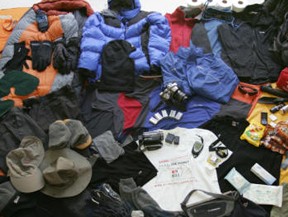Kilimanjaro Kit List
Trekking Kilimanjaro could be the biggest expedition of your life, don’t let poor preparation let you down.
You can see from our Kilimanjaro Kit Download, that you need to be prepared for all weather types when trekking Kilimanjaro.
There is a simple reason for this; you can expect to experience all weather types during your Kilimanjaro Climb!
Before we jump into the kit, let’s just have a quick look at why we can expect such a variation of weather on the mountain.
Firstly, the different winds in the region are responsible for the amount of rainfall Kilimanjaro receives. The wind carries moisture from the ocean and when it collides with the mountain, it rises, cool and condenses, which forms clouds, rain and snow.
Avoiding the rainy season is a priority for us and we’ve had perfect weather for past three Octobers that we have run our Kilimanjaro trips.
Secondly, The weather on Kilimanjaro is also heavily influenced by changes in altitude to the extent that there are distinct climatic zones on the mountain:
The Rain Forest Zone (800 - 3,000m) Expect high humidity and light drizzle at a minimum.
The Low Alpine Zone (3,000 - 4,200m) From 3000s, the rainforest quickly develops into grasslands and moorlands. Temperatures can drop to sub-zero level in the evenings.
High Alpine Zone (4,200– 5,000m) This zone is characterised by a desert environment. Day temperatures are hot and solar radiation is high so sun lotion is essential.
Glacial Zone (5,000m to 5,895m) Pure artic conditions, you must be prepared!
Now you’ve got a little more insight into why the Kit List is rather extensive, let’s get to it….
Bag / Sleeping
You need one large bag and one small bag. A porter carries the large bag, normally a mountain holdall with a maximum of 16kg of weight.
The smaller bag should be a rucksack that is carried by you during the day. For this reason the bag is referred to as a “Daysack” in our Kit List download.
You will not have access to your holdall during the day, only at the campsites where your tent will be situated each day.
Your sleeping bag and sleeping mat are likely going to be two of the largest items in your holdall but also two of the most important.
The temperate can get seriously cold on Kilimanjaro with temperatures dropping to zero from as early as 3000m into the climb. Therefore your sleeping bag needs to be a good quality and warm (-10c rating).
The sleeping mats are used as a buffer between you and the cold and rocky floor so a decent one could be the difference between a good and bad night’s sleep.
Clothing
Whenever I’m preparing for a challenge, I always think about items closet to the body first. I then work up the body from feet to head before squeezing items into packing sacks to save space.
The first items therefore are base layers; here I recommend purpose built clothing that helps with body insulation and keeps moisture away from the skin. A decade ago, it was all about the ‘Helly-Hanson’, I’ve still got many of their items today but now there are loads options for base layers. ‘Ice Breaker’ and ‘Under Armour’ are two brands I use and recommend.
The base layers should consist of upper and lower body items, plus I would include thin socks in the ‘base layer’ section of my personal kit check.
From here, we add the basic trekking clothing – trousers (personally I like ones that can be made into shorts as well), lightweight t-shirt, lightweight fleece, waterproof jacket, walking socks and of course – good quality walking boots.
There is such a wide range of clothing manufacturers available but my personal favourites and recommendations would be The North Face and Mountain Equipment.
Now for ensuring the extremities of the body are kept warm and protected – I recommend a woolly hat, sun cap, mittens, thick gloves, a balaclava and a buff.
Finally, the attention turns to kit required during the downtime (and summit night) – Long johns, head torch (spare batteries) and a warm insulated jacket.
As you are trekking for a number of days, it makes sense to take extras of some of the mentioned items including trousers, t-shirts, socks and base layer wear.
The altitude is enemy number one on Kilimanjaro but the temperature is enemy number two so it’s essential to invest in good, quality kit and prepare for all eventualities.
For a flavour of the different temperature and terrain, see our Go Pro Kilimanjaro video of our 2016 challenge.
Think you're not fit enough for Kilimanjaro? Make sure read this blog - How fit to climb Kilimanjaro?
Keep on moving!

